As the temperatures start to rise in the lead up to the summer, especially with the latest temperature records soaring in 2019, many insects emerge from resting and begin to fill the great outdoors. While most insect bites are mild and don’t cause great discomfort, scratching the area can lead to bacteria entering the skin barrier, causing an infection. Read on to learn about the common stings, their treatment, aftercare, as well as what to do in an event of infection of the bite!
Guide contents:
- Insect bite treatment & tips
- Home remedies for mosquito bites
- What are the symptoms of an infected insect bite?
- How to treat an infected insect bite
- Infected insect bite - when to seek medical advice
- Insect bite reactions & how to relieve itching
- Reducing swelling of insect bites & stings
- What are the common insect bites & stings?
- Tips for preventing bites
Insect bite treatment & tips
If you do end up getting bitten, there are some steps you should take to help treat the symptoms:
- Sting removal. The sting/tick/hairs of the insect might be left in the wound following a sting, which should be removed by hand or scraped out sideways with a hard-edged object. Avoid using tweezers for removal.
- Gently clean. The area should be washed with soap and water.
- Apply compress. If you experience swelling, you can apply a cold compress for 10 minutes and elevate the area if possible.
- Consider antihistamine for relief. If you’re experiencing a mild allergic reaction or itching, you can take an antihistamine tablet to help.
- Treat the pain. If you are experiencing pain, you can take over-the-counter painkillers (please note that aspirin shouldn’t be given to anyone under the age of 16).
Consider topical at-home treatments for further relief. You can also use topical treatments to help with the symptoms. Savlon Bites & Stings Relief Gel is a multi-action formula that helps relieve pain, reduces the itching caused by insect bites and helps to protect the bites from infection.

Savlon Bites & Stings Pain Relief Gel
Soothes, protects and relieves the pain and itching caused by insect bites and stings, so you can get on with your day.
Home remedies for mosquito bites
Mosquito bites are often harmless but can be itchy and irritating. There are a few home remedies that can ease the pain and itching such as the following:
- Oats can relieve itching and swelling as they’re reported to have anti-irritant properties. Simply mix with water to create a paste-type substance and apply to the affected area.
Top tip: If the affected area is wide-spread, sprinkle 1 cup of oats into a warm bath, occasionally rubbing the oats into the skin.
- Aloe vera is well-known for its anti-inflammatory properties which is why it’s commonly used to help heal minor wounds and calm infections.
- Ice is also well-known for being anti-inflammatory as it numbs the skin and provides short-term relief.
Top tip: Put a barrier between the ice and the surface of the skin to avoid ice burn.
- Chamomile tea is a common natural remedy and can be used to ease skin irritation, speed up healing and reduce inflammation. To use chamomile tea on a mosquito bite, steep a chamomile tea bag in cold water for 30 minutes and leave it in the refrigerator. Squeeze all the excess water from the tea bag and apply it directly to the bite.

What are the symptoms of an infected insect bite?
Sometimes bacteria can enter the body if the skin barrier has been broken, which can also be caused by a bug bite or scratching the affected area due to itching.
This can lead to a skin infection, otherwise known as cellulitis. It can occur anywhere on the body but is most commonly on legs.
Symptoms of infection include:
- Tenderness and inflammation in the affected area
- Warmth/heat radiating from the skin
- Redness
- Red streaks near the affected area
- Enlarged lymph nodes
- Drainage & pus in the affected area
- Fever & chills

How to treat an infected bug bite
Sometimes bacteria can enter the body if the skin barrier has been broken, which can also be caused by a bug bite or scratching the affected area due to itching.
This can lead to a skin infection, otherwise known as cellulitis. It can occur anywhere on the body but is most commonly on legs.
Symptoms of infection include:
- Tenderness and inflammation in the affected area
- Warmth/heat radiating from the skin
- Redness
- Red streaks near the affected area
- Spots near the affected area
- Dimpling
- Enlarged lymph nodes
- Drainage & pus in the affected area
- Fever & chills

Infected insect bite - when to seek medical advice
- If you experience any symptoms of infection, it’s important to consult your GP as you might need antibiotics to treat it
- It’s crucial to act promptly once you notice symptoms of infection as it’s easier to treat early on and reduces the likelihood of the infection progressing to a more severe condition, such as Sepsis
Go to A&E or call 999 if you experience any of the following symptoms alongside those of cellulitis outlined previously:
- High temperature and fever
- Fast breathing or heart rate
- Dizziness or feeling faint
- Cold & clammy skin
- Purple patches on skin
- Disorientation
- Loss of consciousness

How to treat an infected bug bite
At the beginning of infection or for mild cases of infection, you might be able to treat an infected bite at home with a few steps:
- You should clean the area with water & soap thoroughly & try to avoid touching.
- If it’s causing discomfort, apply a topical treatment like hydrocortisone cream to help relieve the itching.
- Over the counter (OTC) topical antibiotic creams may also be used to treat minor infections at home.
- Keep the infected area covered to help recovery.
- If at-home treatment doesn’t work or the infection is more severe, an infected insect bite can be treated with a course of antibiotics so visit your GP. It’s very important to complete the full course of antibiotics if they’ve been prescribed even if the symptoms have eased as the infection may still be prevalent.
- Less common but more severe insect bites, such as spider bites, may require intravenous antibiotics to quickly treat the infection in your system.

Savlon Bites & Stings Pain Relief Gel
Soothes, protects and relieves the pain and itching caused by insect bites and stings, so you can get on with your day.
Insect bite reactions & how to relieve itching
The body’s natural first reaction to an insect bite it to release chemical histamine as a form of protection. This histamine release can then cause itching, redness and swelling. Here are a few ways to relieve the irritating itch that can be caused:
- Hydrocortisone cream: Anti-inflammatory topical creams, such as hydrocortisone cream, can be used to help minimise itching, redness and swelling.
- Oral antihistamine: Antihistamines work to counter the effects of the natural histamine produced by your body.
- Cold compress/ice: Although the effects of a cold compress are only temporary, it is an effective way to reduce itchiness by numbing the skin.
- Savlon Bites & Stings Pain Relief Gel can be applied to soothe and relieve the pain and itching caused by insect bites and stings.
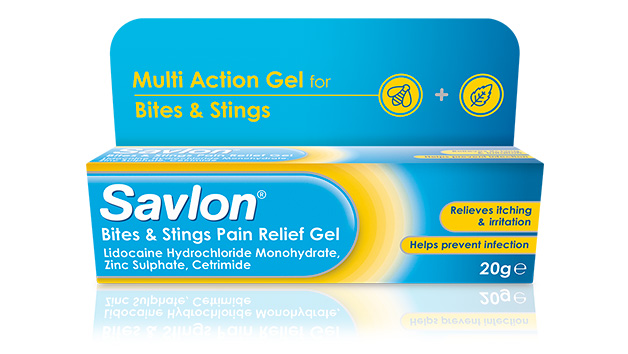
Reducing swelling of insect bites & stings
Swelling and inflammation are part of the body’s natural reaction to being bitten by an insect or bug. Swelling will naturally reduce but there are a few ways to speed it up.
- Cold compress: Soak a flannel or towel in cold water and apply to the skin. Re-soak and rinse the flannel to keep the area cool as time goes on.
- Ice pack: Ice will naturally cool down the area and reduce swelling as well as numbing the area to reduce itching.
- Pain relief tablets: Over-the-counter pain relief such as paracetamol and ibuprofen can be taken to reduce pain and swelling. Please note that aspirin shouldn’t be given to anyone under the age of 16.
- Elevation: Keeping the affected area elevated for at least 15 minutes will reduce the blood flow and pressure.

What are the common insect bites & stings?
Mosquitoes
Mosquitoes tend to emerge in springtime due to the increase in temperatures and wet climates, which are perfect conditions for them.
Common symptoms: their bites present as small red bumps or soft bumps and can be incredibly itchy, causing many to scratch which can cause irritation and pain. Those more sensitive to bites might also develop blisters or experience swelling. The symptoms can present within seconds or up to 48 hours, with most of the symptoms disappearing after 3-4 days.
Infection symptoms: sometimes if scratching breaks the skin barriers and bacteria enter, it might cause an infection. This often presents itself as puss, heat in the area and severe redness. Read ‘How to treat infected bug bite’ below for tips on how to treat the infection.

Midges/gnats
- Often resembling mosquitoes, these insects often are easy to spot in swarms lingering around still water and streams, producing a humming sound.
- In the UK, there are both biting and non-biting species, however only the females bite.
Common symptoms: midge bites resemble those of mosquitos, presenting small red lumps which can be both itchy and painful. Those people who are sensitive to insect bites might develop fluid-filled blisters.
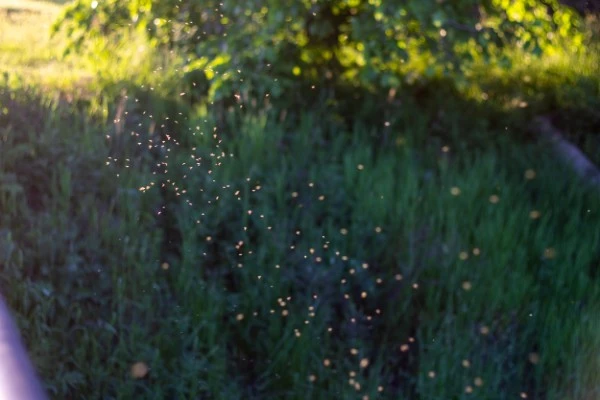
Bees
- Often taken for granted, bees spread pollen to many of the common plants in our gardens and the wild, which could not thrive without them.
- Bees only tend to sting if they’ve been frightened or if their colony is under attack. Only the female workers and the queen bee can sting.
Common symptoms: instant burning pain, swelling, red welt and left behind sting/hairs in the area of the sting.
Allergic reaction symptoms: extreme redness, swelling that continues to enlarge over the next 2 days, hives, difficulty breathing, swelling of the throat and tongue, nausea, dizziness and fainting. If you experience any of these symptoms, seek medical help by dialling 999.
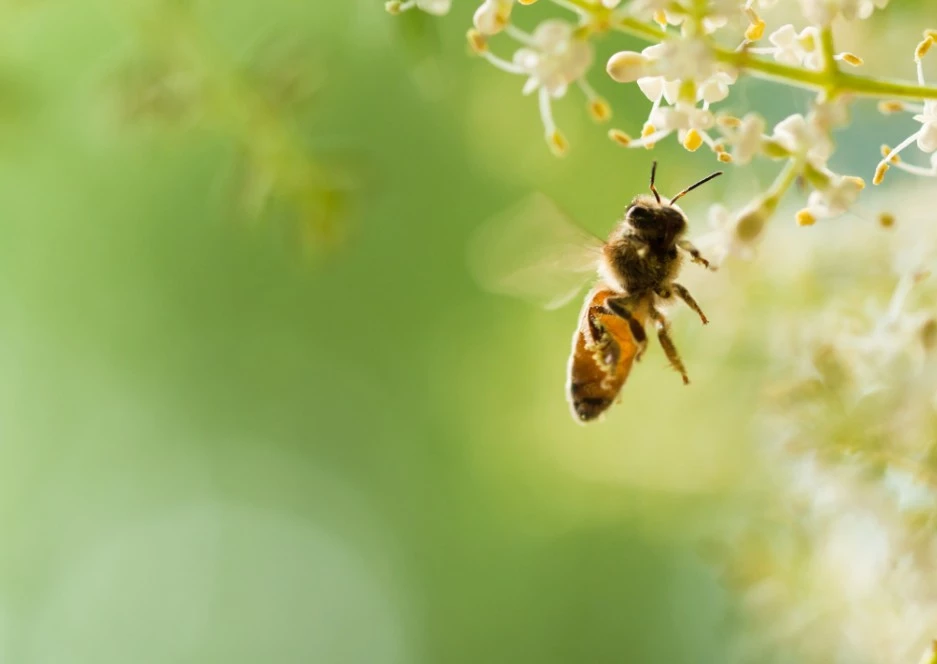
Wasps/hornets
- While wasps are a common insect-controlling predator in the UK, feeding on small insects such as flies and spiders, however sometimes they will also sting humans to defend themselves or their nest.
- Hornet is a larger wasp, however it is actually often less aggressive than the common wasp.
Common symptoms: sudden and sharp pain following a sting, redness and in some cases itching. Wasps don’t leave their sting behind so they could sting you again.
Allergic reaction symptoms: pain, redness and swelling of the area around the sting often indicates a minor allergic reaction . More severe allergic reactions present anaphylaxis, difficulty breathing, swelling of the face, throat or tongue, as well as dizziness. If you experience any of these symptoms, seek medical help by dialling 999.
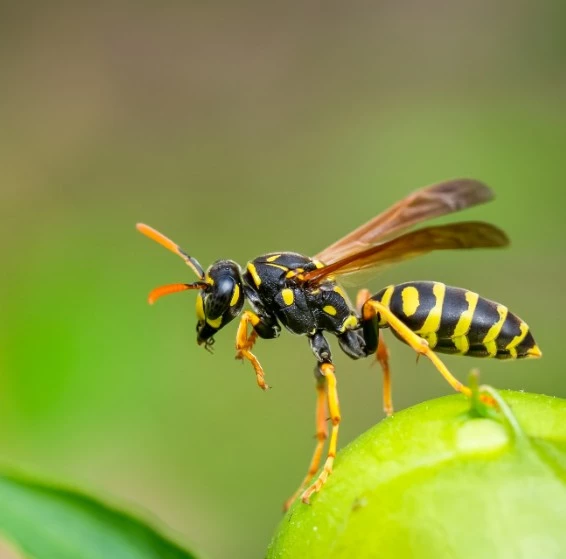
Fleas
- Fleas are often associated with pets, however there are many different species, including human fleas.
- They reproduce very quickly, which makes it difficult to get rid of them without pesticide treatment.
Common symptoms: small red bumps in clusters of 3 or 4, severe itching, in some cases pain.
Allergic reaction symptoms: mild reactions might present raised welts, whereas more severe reactions might present in the form of anaphylaxis, difficulty breathing, swelling of the face, throat or tongue, as well as dizziness. If you experience any of these symptoms, we would urge you to seek medical help by dialling 999.
Infection symptoms: white-topped blisters, severe redness, heat, puss from affected areas. Read ‘How to treat infected bug bite’ below for tips on how to treat the infection.

Bedbugs
- Bed bugs are small, oval insects with adults measuring at around 5mm long.
- They most often hide in bed frames, mattresses and bedding, however they can also hide in other furniture, clothing, behind pictures and loose wallpaper. Even though bed bugs can’t fly, they’re able to move quickly and across many different surfaces due to their small and flat shape.
- This makes bed bugs hard to get rid of, hence in most situations, you would need chemical treatment from pest control.
Common symptoms: small bites in a line or a cluster, spots of blood on bedding, small brown spots on furniture, sometimes a musty odour.
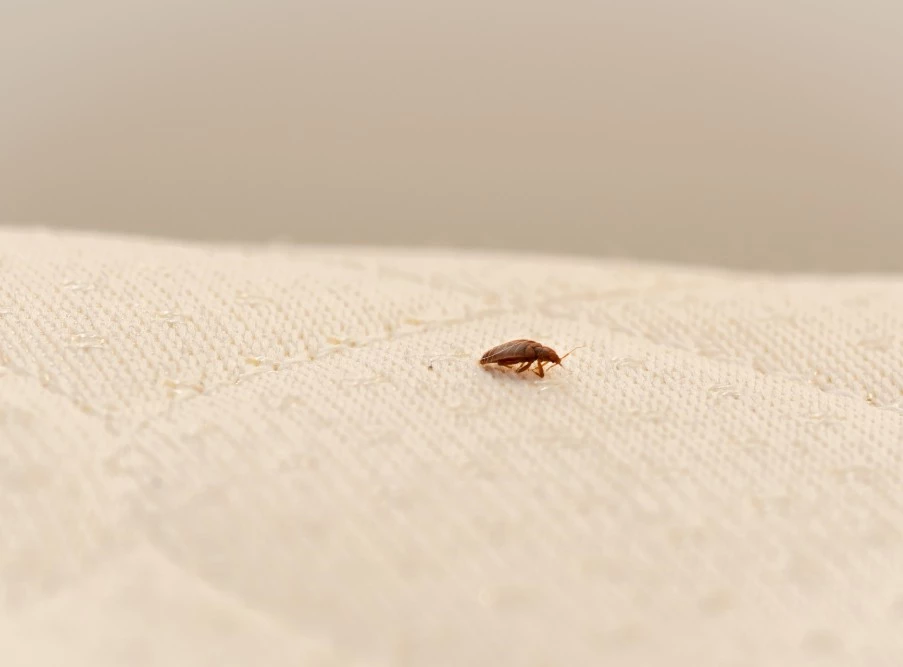
Tips for preventing bites
While most insect bites come with mild symptoms, the nuisance and irritation that comes with it becomes much dreaded by many of us in the warmer months. Hence, the best option is to take steps and plan ahead to prevent bites and stings in the first place.
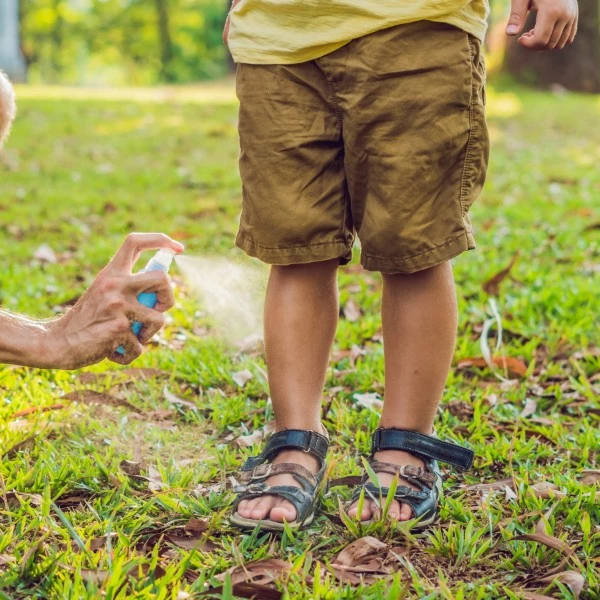
Use insect repellent sprays
It’s recommended to use an insect repellent that is 30% DEET (active ingredient in many insect repellents), which has been suggested to provide the same amount of protection for up to 8 hours as the higher concentrations of DEET with a larger chance of skin irritation and side effects.

Wear protective clothing & footwear
Dressing in clothing that covers as much skin as possible and wearing shoes outdoors reduces the risk of insects coming in contact with skin directly. Wearing light coloured clothing would also help to spot ticks, so it’s recommended for any situations where you might be at an increased risk.

Close the windows/doors when possible
This reduces the likelihood of the insects to get inside, especially during the hotter months or when travelling abroad.

Invest in a mosquito net
For extra protection, use insecticide-treated nets covered in insecticide which are deadly to mosquitoes, however harmless to people and pets. This is especially important in hot climate countries affected by more severe carrier diseases, such as malaria. Make sure that the net reaches the floor or is tucked under to remove ways to enter.

Stay calm
If you are around a wasp, bee or a hornet, do not make sudden movements and swat them away - this will only aggravate them more increasing the likelihood of you getting stung.

Be aware of your surroundings
Avoid camping near water, such as ponds, which tend to attract mosquitoes and horseflies. If you spot any insect nests, wasps, bees or ants, try to avoid the area and never try to remove the nest yourself.

Food, drink and strong smells
Make sure to cover any food, cans & bottles, especially when outside, as they can often attract bugs. It’s also important to consider that any perfume or strong-smelling hygiene products are likely to do the same.
If you have any rubbish or waste out, ensure to secure the bags or containers to ensure protection against insects.

Flea treatments for pets & homes
Prevent fleas from becoming a problem by regularly treating both your pet with a specialised flea treatment and your home, which may need to be done all year round if your home is centrally heated.



